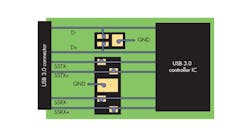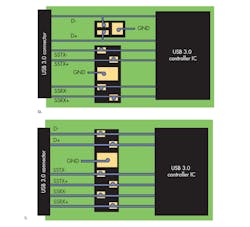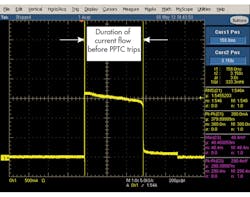Virtually every consumer electronic device and appliance must comply with standards that ensure consumer safety. Adding circuit protection, then, is a necessary first step in the product design process. In addition to battery protection (see “Understanding Lithium Batteries in Portable Electronics"), manufacturers of these applications require I/O port and motor protection.
I/O Port Protection
The USB, HDMI, and eSATA ports in our smartphones, tablets, automotive infotainment devices, and other gadgets make them easy to connect to other devices. However, these high-speed interfaces are sensitive to electrostatic discharge (ESD). The International Electrotechnical Commission (IEC) has designated a safety standard to guard against these damaging events called “IEC 61000-4-2, Testing and measurement techniques – Electrostatic discharge immunity test.”
The IEC’s 8-kV contact and 15-kV air discharge standards often are not high enough to guard against the severe charged board events (CBEs) that high-speed interfaces are often subjected to, though. A high peak current and fast rise time distinguish these extremely strong surge events. The duration of these events is very short, in the nanosecond range, unlike power-line and lightning surges that are typically in the microsecond range.
This file type includes high resolution graphics and schematics when applicable.
Using silicon ESD (SESD) devices in port applications can help designers address real-world, human-created ESD events. SESD devices can be found in single-channel, two-channel, four-channel, six-channel, and other types of configurations. They can be rated for the 8-kV contact and 15-kV air discharge found in the IEC standard, or they can exceed this standard.
Devices rated for 20-kV to 22-kV contact discharge help provide protection well in excess of the IEC standards. Equipment used in industrial, medical, or even abusive consumer applications, often is designed to withstand ESD events that are much more severe than those specified by the IEC standard.
Two-channel, four-channel, and six-channel SESD devices all can be used to help protect the power and data lines in a USB 3.0 port (Fig. 1). It often comes down to the board designer’s personal preference when choosing a combination of devices. These multi-channel, flow-through devices offer the simplest layouts.
The choice may depend on the availability of similar parts from multiple sources, preferred suppliers, or cost. Generally, the more channels of protection in a single device, the lower cost per channel. Placing many single-channel parts will probably give you the highest cost per channel, but it will also allow the most choices from multiple suppliers.
The capacitance of the SESD device is another factor to consider. At high frequencies, like those found in HDMI, USB 3.0 and 3.1, eSTATA, and Thunderbolt ports, a few picofarads of capacitance can attenuate the signal and limit the data rate. SESD devices with capacitances in the 0.1- to 0.3-pf range are available. This amount of capacitance does not affect data rates at these frequencies.
Motor Protection
Motor stalls in appliances are another issue manufacturers need to protect against. For example, a typical smart sweeping robot, or robot vacuum, must comply with various safety standards, including requirements specified in IEC/EN60950, UL1017, and EN 60335-1.
A vacuum can become entangled with debris, which can cause the motor to stall. When this happens, although the voltage is still being applied to the motor, the motor cannot turn. This causes a high stall current to flow, which in turn causes the temperature of the motor to rise rapidly. When the temperature exceeds the rating of the motor coil, the coil can burn out and the motor can fail. This not only inconveniences the consumer, it can also add to the cost of warranty repairs incurred by the manufacturer.
A fuse can be used to limit motor current during a stall, but when it trips, it must be replaced. A polymer positive temperature coefficient (PPTC) device can be used as a resettable alternative to a fuse. When the temperature of a PolySwitch resettable PPTC device rises above a certain threshold, it switches from a low-resistance state to a high-resistance state, limiting the current through the device. When mounted on a motor, it senses when the motor stalls and limits the current through the motor, helping to prevent burnout.
A PolySwitch PPTC device reacts to both temperature and current, so mounting it in close thermal contact to the motor windings will cause it to react faster. When the stall condition is removed and the motor cools down, the PolySwitch PPTC device reverts to its low-resistance state and the motor can operate normally once again.
Consider a vacuum’s motor that operates at 22.5 V dc and draws a current of 0.3 A. A common surface-mount PolySwitch PPTC device, such as the miniSMDC050F with a 500-mA hold current and voltage rating of 24 V dc, could be used here. While 500 mA may seem like a higher hold current rating than necessary, PPTC devices have a thermal derating that needs to be considered.
If the ambient air temperature inside the vacuum reaches 50°C, the hold current rating will decrease (relative to its hold current at 20°C). Manufacturers of PPTC devices normally provide thermal derating tables. The miniSMDC050F derates to a hold current of 0.43 A at 50°C. This means that at steady state currents of 0.43 A or less, at an ambient temperature of 50°C, the PPTC will not trip.
We tested how the device responded to a motor stall when operating at an ambient temperature of below 10°C. Simulating a stalled motor using a constant-current source, we first set the current to the typical operating current of the motor and then increased the current to the value typical of a stalled motor. The real-time response of the PPTC device is 3.0 seconds, far less than the 10 seconds in the standard that was required for this vacuum (Fig. 2).
Conclusion
To comply with safety standards for consumer portable products and small appliances, it is essential to build in circuit protection when initiating the design. By using SESD devices for port protection and PPTC devices for motor protection, designers can exceed the requirements set forth by the industry standards and therefore help provide manufacturers with safer, more reliable products.
Barry Brents is a field application engineering manager with TE Circuit Protection, a business unit of TE Connectivity. A member of IEEE and former U.S. Navy nuclear submarine officer, he has been involved in the power and communications industries since 1989. He received his BSEE from Texas Tech University.



